- Home
- Brian Falkner
Task Force
Task Force Read online
RECON TEAM ANGEL
The Assault
Task Force
ALSO BY BRIAN FALKNER
The Tomorrow Code
Brain Jack
The Project
This is a work of fiction. Names, characters, places, and incidents either are the product of the author’s imagination or are used fictitiously. Any resemblance to actual persons, living or dead, events, or locales is entirely coincidental.
Text copyright © 2012 by Brian Falkner
Jacket art copyright © 2013 by Alan Brooks
Map copyright © 2013 by Jeff Nentrup
All rights reserved. Published in the United States by Random House Children’s Books, a division of Random House, Inc., New York. Originally published in paperback in Australia and New Zealand by Walker Books Australia, Newtown, in 2012.
Random House and the colophon are registered trademarks of Random House, Inc.
Symbol art by snoopydoo
Visit us on the Web! randomhouse.com/teens
Educators and librarians, for a variety of teaching tools, visit us at RHTeachersLibrarians.com
Library of Congress Cataloging-in-Publication Data
Falkner, Brian.
Task force / Brian Falkner. — 1st ed.
p. cm. — (Recon Team Angel ; bk. 2)
Summary: The six teens of Recon Team Angel, having spent years mastering alien culture so that they can talk, act, and think like their enemies, now have their target in sight but time is running out to save humanity and themselves.
ISBN 978-0-449-81299-0 (trade) — ISBN 978-0-449-81300-3 (lib. bdg.) — ISBN 978-0-449-81301-0 (ebook)
[1. Extraterrestrial beings—Fiction. 2. War—Fiction. 3. Undercover operations—Fiction.
4. Adventure and adventurers—Fiction. 5. Australia—Fiction. 6. Science fiction.] I. Title.
PZ7.F1947Tas 2013 [Fic]—dc23 2012038142
Random House Children’s Books supports the First Amendment and celebrates the right to read.
v3.1
For Kym, Roy, and Alyssa
The future belongs to those who believe in the beauty of their dreams.
—Eleanor Roosevelt
CONTENTS
Cover
Other Books by This Author
Title Page
Copyright
Dedication
Maps
Prologue
BOOK 1—THE ISLAND
Epigraph
1. Invasion Force
2. Barracudas
3. Demons
4. Patrol Ship
5. St. Helena
6. Kriz
7. The Longest Night
BOOK 2—THE RIVER
8. Operation Magnum
9. SONRAD
10. Viper Channel
11. Man Down
12. The Race for Amberley
13. Uluru
14. Steel on Target
15. Armor
16. Reservoir Hill
17. Minefield
BOOK 3—THE LAKE
18. Kommandos
19. Bad Timing
20. Warrego Highway
21. Yozi
22. Wivenhoe
23. Fluid Dynamics
24. Buoys with Bombs
25. The Dam
26. The Flood
27. Angels
End Note
Epilogue
Glossary
Congratulations
About the Author
PROLOGUE
THIS IS NOT A HISTORY BOOK.
The achievements of 4th Reconnaissance Team (designation: Angel) of the Allied Combined Operations Group, 1st Reconnaissance Battalion, from November 2030 to July 2035, during the Great Bzadian War, are well documented by scholars and historians. Less well known are the people behind the myth: the brave young men and women who earned the reputation and the citations for which Recon Team Angel became famous.
These are their stories, pieced together from Post-Action Reports and interviews with the surviving members of the team. The stories of the heroes whose skills, daring, and determination changed the course of history.
Where necessary to gain a full understanding of the situations these soldiers faced, accounts have been included from the forces they opposed: from interviews with prisoners and Bzadian reports of the battles.
The members of Recon Team Angel changed over time, due to injury and death, as happens in a combat arena. By the end of the war, over seventy young people had served in the unit. They were aged fourteen to eighteen—small enough to pass themselves off as alien soldiers, but old enough to undertake high-risk covert operations behind enemy lines.
At its peak, this remarkable group boasted a core of twenty-five specialist operatives. But only six “Angels” infiltrated Australia as part of the ill-fated Operation Magnum:
Angel One: Lieutenant Ryan (Lucky) Chisnall—United States of America
Angel Two: Sergeant Trianne (Phantom) Price—New Zealand
Angel Three: Specialist Janos (Monster) Panyoczki—Hungary
Angel Four: Private First Class Blake Wilton—Canada
Angel Five: Specialist Dimitri (The Tsar) Nikolaev—Russia
Angel Six: Specialist Retha Barnard—Germany
May we always remember the names of those who fell in the pursuit of liberty for Earth.
We celebrate our military victories,
but try to forget our failures.
Operation Magnum, however, will never be forgotten.
More than a failure, it was a glorious disaster.
—General Harry Whitehead
1. INVASION FORCE
THE ARMY CAMPED ON THE CHUKCHI PENINSULA IN FAR northeast Russia was the largest assembled in the Bzadian War, poised for the greatest invasion in Earth’s history.
The buildup took several months, but by the end of November 2031, there were 7,000 rotorcraft; 5,000 jet aircraft, including 800 of the formidable and heavily armed “Dragons”; 35 tank battalions; and 60 full infantry divisions. Over a million Bzadian soldiers—complete with artillery and logistical support—occupied the inhospitable and frozen wastelands of the peninsula and waited for winter.
Less than a hundred miles away lay Alaska and the pathway to the Americas. As soon as the turbulent waters of the Bering Strait turned to ice, the invasion of the Americas would begin, and with it the beginning of the end of the human race.
On the other side of the strait, human forces also waited. But after seven years of warfare against the mighty Bzadian Army, Earth’s defenses were little more than a thin crust ready to oppose the invasion.
For the aliens, the invasion could not come soon enough. The massive army was a ravenous beast that needed constant feeding. Over 30,000 tons of food and supplies were being trucked into the peninsula each day. Nearly half of that was fuel. The huge battle tanks would use up a fuel cell in two days, the mighty Dragons in just eight hours.
In the Americas, military commanders did what they could to prepare for the coming holocaust. On December 10, representatives from twelve nations—those that still had any significant military capability—met in the war room of the Pentagon to make what plans they could.
General Elisabeth Iniguez, the commandant of the US Marine Corps and a member of the US Joint Chiefs of Staff, was the instigator of what later came to be called Operation Magnum.
General Iniguez, a fiery redhead, stood up and slammed her hand down on the table. “Invade us? Invade us!” she said. “How about we invade them! Those alien freaks.”
Her plan was an audacious one, never before attempted. An attack in the heart of the Bzadian Empire, in New Bzadia itself (formerly known as Australia). It called for an amphibious task force to sail down the Brisbane River right under the noses of the al
iens. The target was the aliens’ fuel-processing plant at Lowood. Without the constant flow of fresh fuel cells, the Bzadian Army would be paralyzed. By the time they could rebuild or repair the plant, the winter would be over and the threat of invasion gone for another year.
The plant was heavily protected by ground-to-air missile batteries, which ruled out an air attack. But an even bigger problem was the Amberley Air Base.
The massive Bzadian air force base located near Ipswich, west of Brisbane, was formerly the largest base of the Royal Australian Air Force and one of only three major air bases in Australia still with its full complement of rotorcraft and fighter jets. All the other bases were operating at lower levels, as their aircraft had been shipped to Russia to support the coming invasion of the Americas. Amberley, and its massed aircraft, had to be taken out of action for the operation to proceed.
General Iniguez knew that everything depended on destroying the air base. If not, then the entire expeditionary force would be wiped out. In her opinion, Operation Magnum was going to be either the biggest triumph of the war or the biggest catastrophe.
As the meeting broke up, General Harry Whitehead, the tall, gray-haired, and soft-spoken supreme commander of ACOG, took Iniguez aside and asked, “Are you sure this can be done?”
Iniguez replied, “I believe so, sir.” She looked closely at him and said, “But we’ll need Angels on our shoulders.”
2. BARRACUDAS
[MISSION DAY 1, DECEMBER 31, 2031]
[1725 hours Local time]
[Virginia Class Submarine: USS JP Morgan, Coral Sea off the coast of Queensland, Australia]
“BRING HER UP TO SIXTY FEET.”
“Sixty feet, aye. Pump from number one auxiliary to sea.”
“Very well. Bring her up slowly. Sonar?”
“All clear.”
“Showing sixty feet and steady.”
“Come to two eight five. Slow ahead both.”
“Two eight five, aye. Pump-jets one and two answering slow ahead both.”
“Very well. Angel One, this is First Officer Kavanagh. Please confirm your team is ready to Echo Victor.”
Inside the lockout trunk, Lieutenant Ryan Chisnall made an “okay” sign with his thumb and forefinger. The universal diving sign for “all okay.” It was both a question and an answer, and the five members of his team responded with matching gestures.
“Angel Team confirmed ready for Echo Victor,” Chisnall said.
“Very well. Vent and flood LOT.”
“Lockout trunk venting and flooding, aye.”
Chisnall pressed his full-face mask firmly to his skin as air hissed out of the chamber and cold seawater rose rapidly around him. There was no need; the mask was well secured. It was just habit.
Lights in the chamber began to dim. The shapes of his five Angel Team members faded into the background, then disappeared completely.
He flicked the night-vision switch on the side of his mask and the interior of the chamber took on an unearthly green glow, his teammates now black ghosts silhouetted against it.
The lockout trunk, a staging area built into the submarine, was for US Navy Seals, allowing them to deploy without the submarine needing to surface. It was designed for nine adults, so for six small teenagers it seemed spacious. Plenty of room for a party. But the six teenagers in this room were not here to party.
“Buddy up and check equipment,” Chisnall said as the last of the air hissed out of the chamber. He was now enclosed in a metal box, well below the surface of the ocean, with only his breathing apparatus to save him from a certain, horrible death.
It didn’t concern him. Nothing much concerned him nowadays. Not since Uluru.
He turned around so Private First Class Blake Wilton could check his equipment.
Uluru was the first ever Angel mission, and he had been in charge. They had completed the mission and destroyed the secret alien project hidden inside the giant rock in the Australian desert. But the cost had been great, physically and psychologically.
The bulky shape of Specialist Janos “Monster” Panyoczki moved to the much smaller, willowy form of Sergeant Trianne “Phantom” Price, and his hands began moving over the hoses and knobs of her rebreather kit. She pulled away from him briefly, then relaxed, with a quick glance at Chisnall, and allowed Monster to complete the check.
What is up with those two? he wondered.
Specialist Retha Barnard, a stocky fifteen-year-old German, did the checks with Specialist Dimitri “The Tsar” Nikolaev. Barnard’s check seemed short and perfunctory, but Chisnall knew it was probably more thorough than those of any of the others in the team.
Barnard and the Tsar, the two newest members of the team, didn’t seem to get on particularly well, and Chisnall had buddied them together for that reason. Learning to rely on each other in life-or-death combat situations was a good way to get over petty personal differences.
He had put Monster and Price together for much the same reason. Since Uluru, there had been some kind of tension between them, which both of them denied when he asked about it. But something had changed; Chisnall was sure of it.
A lot of things had changed since Uluru.
Monster had changed. He seemed to have developed a more spiritual side. He was still funny, rude, and rough as guts, but after Uluru he appeared to have started thinking more deeply about things. Most of the conversations Chisnall now had with his friend were on the nature of life and the universe. Chisnall didn’t mind. It made for some interesting late-night discussions, and he felt that Monster was just trying to find his way. To figure out his place in the world.
With Brogan gone, the team had needed another medic, and Monster had volunteered for the training. He seemed more interested in helping others than in hurting them, although Chisnall was still confident that he would pull his weight when it came to the fighting.
Brogan. His sergeant on the last mission. But she had been more than that. Much more. Chisnall tried not to think about her. The one person he had absolutely thought he could trust had turned out to be the one person he couldn’t. That betrayal had changed something in him, and he didn’t like it.
Wilton finished checking Chisnall’s equipment and turned around so Chisnall could return the favor. A couple of tubes, a couple of knobs, all were as they should be. But Chisnall already knew that. He had checked it when they had suited up, and then again when they had entered the chamber. He tapped Wilton on the shoulder to let him know he had finished.
Unlike a scuba set, the closed-circuit rebreathers used a bottle of liquid oxygen with sofnolime cartridges to remove carbon dioxide. With scuba gear, most of the oxygen in the tank was wasted, expelled into the ocean every time the diver exhaled. With the rebreathers, very little was wasted. More important, though, the closed-circuit system eliminated any telltale bubbles on the surface, and the full-face masks allowed for underwater conversations through built-in microphones.
“Equalize pressure.”
“Equalizing valves open, ambient sea pressure reached.”
“Unlock the hatch. Angel Team is clear to EV.”
“Open this tin can up for us, would you, Monster?” Chisnall said.
Monster launched himself up off the deck and braced with one hand on a railing while he spun the wheel that opened the hatch.
The pitch-black of the lockout trunk changed as the hatch door opened, letting in the light of a completely different world: the ocean outside the submarine. It was not bright, just a gentle shimmering of light through the waves, thirty or so feet above them.
Chisnall flicked off his night vision. There was no need for it outside. Not yet.
Monster was first out and waited by the hatch for the rest of the team to emerge before spinning the wheel again to close it.
“Angel Team is EV. Unlocking stowage lockers.” The first officer’s voice was in his ear again.
The submarine was a long gray tube, smooth as oilskin, stretching away into the murk of the water behin
d them. There was a strange beauty to the symmetry of the vessel, broken only by the sail, the squat tower that jutted from the hull of the submarine close to the nose.
Price was first to the sail, where the stowage lockers were located, and she opened the flat panels to allow Angel Team to access the equipment stored inside. The first three compartments held barracuda DPVs, diver propulsion vehicles. Price reached inside the spacious compartment and pulled the first of them out by its tail. It looked like, and was designed to sound like, a large fish. The best efforts of the best engineers trying to create something nature did effortlessly.
Price passed one to each member of the team before extracting her own.
An equipment pod followed, then a small torpedo-shaped object that she floated gently across to the Tsar. He attached it behind his barracuda. A towed sonar array, it would be their eyes and ears in the dark night of the ocean.
“USS JP Morgan, this is Angel One. How copy?” Chisnall said.
“Angel One, this is the USS JP Morgan. Clear copy.”
“Thanks for the ride, guys. We are Oscar Mike.”
“Very well. Goodbye, good luck, and Godspeed.”
“Everybody ready?” Chisnall asked. He got quick nods from everyone, except the Tsar, who thumped his chest twice with his fist and said, “Boo-yah, Big Dog, ready to rock ’n’ roll.”
“Someone forgot to take his medication,” Barnard said.
“No fighting, kids, or I’ll send you to your room,” Chisnall said.
He straddled his barracuda and leaned forward, easing open the throttle and feeling the large tailfin behind him begin to sweep back and forth. He twisted the throttle farther, and with a flick of its tail, the narrow rubberized hull slipped silently through the water.
A week at sea on a Royal Navy destroyer, followed by two days on the submarine. Now it all came down to this. The final stage of their journey back behind enemy lines.
After Uluru, Chisnall had sworn never to return to Australia. He had also sworn he would never again command an Angel mission. Yet here he was.

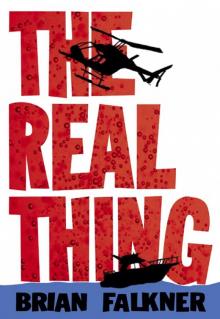 The Real Thing
The Real Thing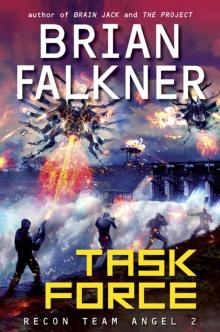 Task Force
Task Force The Flea Thing
The Flea Thing The Project
The Project Clash of Empires
Clash of Empires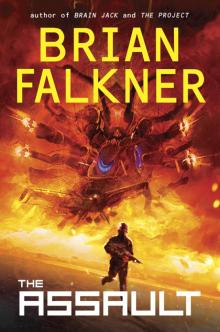 The Assault
The Assault Brain Jack
Brain Jack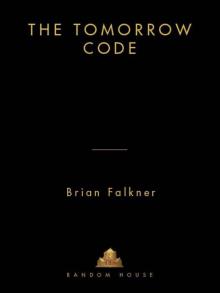 The Tomorrow Code
The Tomorrow Code Vengeance
Vengeance The Super Freak
The Super Freak Northwood
Northwood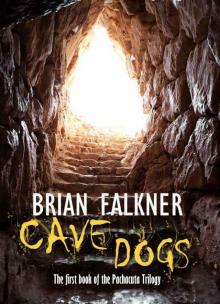 Cave Dogs (Pachacuta Book 1)
Cave Dogs (Pachacuta Book 1) Maddy West and the Tongue Taker
Maddy West and the Tongue Taker